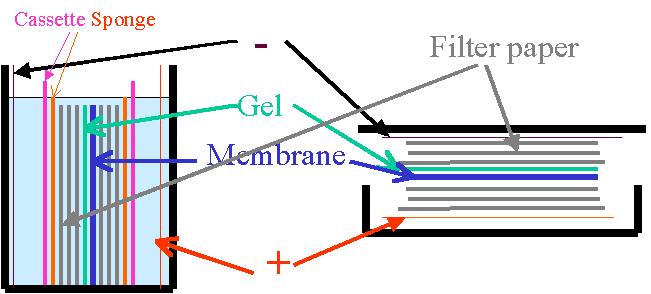|
1. Soak the gel in transfer buffer
(48 mM Tris, 39 mM glycine, 0.037% SDS, 20% methanol) 10-20 minutes.
2. Cut the membrane (Nitrocellulose or PVDF) and
6 pieces of blotting paper to the same size as the gel.
(optional) Mark the well
positions on the membrane with a pen or pencile.
3. For nitrocellulose membrane, wet the membrane in the transfer buffer.
For PVDF membrane, wet the membrane for 15 seconds in 100% methanol,
then soak for 2 minutes in water, then equilibrate the membrane for 5 minutes in the
transfer buffer.
4. Assemble the transfer stack in the following order:
Three pieces of blot paper soaked in transfer buffer
Gel
Pre-soaked membrane
Three pieces of blot paper soaked in transfer buffer
(optional) Align well positions with the markers on the membrane.
5. Make sure no air bubbles get trapped between the gel and the membrane.
6. Insert the stack into a semi-dry or tank blotter as shown. For tank transfer,
sandwich the membrane/gel/filter paper between two sponges and insert into the cassette.
Fill the tank with the transfer buffer.

Figure 1. Electrophoretic blotting systems.
Typically, these systems are used for electrophoretic transfer of
proteins out of polyacrylamide gels. (Left) Tank transfer. (Right) Semidry transfer.
7. Blot at 0.8 mA/cm2 for 1-2 hours, or longer for tank blotter.
8. Remember to mark the side of the membrane with proteins (e.g., by cutting
the right-upper corner).
|